Painters sometimes work from photographs, as explored in my last post, and a cluster before that. Though this has gone on since the medium’s invention in 1839, disclosure of this commonplace fact still comes as a shock to some. Mallika Rao, an arts and entertainment reporter at the Huffington Post, for one, finds it simply outrageous.
Meanwhile, photographers photograph musicians, actors, dancers, and performance artists in performance. Photographers photograph sculptures and other art objects, many of them copyrighted, and license usage rights to the pictures, often without attribution to the artists and usually without consent or payment.
And photographers, not infrequently, stage and photograph reenactments of famous movie scenes, paintings, and other works of art. Just as photographs often inspire painters and other graphic artists, paintings and other works of graphic art frequently serve as jumping-off points for many photographers, sometimes demonstrably and even explicitly so.
My position? Turn about is fair play, insofar as creative practice goes. On that score, we can’t use either the “originality” or the success of the outcome as the gauge for the creative license covering such acts. Once we validate using a work in any other medium as source material, whoever does so has the right to mediocrity and failure.
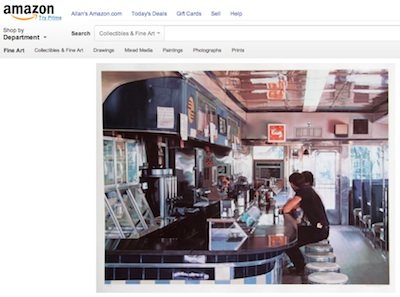
Ralph Goings, “Diner, 1990” (poster), Amazon, screenshot.
Nor does the degree of difference from the original matter: Even a Photo-Realist painter like, say, Ralph Goings, projecting a slide of a photograph onto a canvas, gridding off the canvas, and painstakingly rendering the photographic image in pigments, is not exactly “copying” the photograph ― at least not in the sense that he would be if he took a photograph of that photograph, or laid it down on the platen of a copy machine. He’s not duplicating the photograph, nor scanning it to reproduce it mechanically in pigments. He’s translating it, inch by painted inch, into a different medium.
Given the long history of artists working from photographs, Richard Polsky’s argument at The Huffington Post re Bob Dylan’s paintings that “reproduc[ing] the photos verbatim . . . is not what the art experience is supposed to be about” is merely fatuous, especially since Dylan’s versions eschew the precision of Photo-Realism. As Polsky once ran a gallery through which he marketed for profit the work of Andy Warhol, famous for “reproducing photos verbatim” (certainly more “verbatim” than Dylan), just call him Janus.
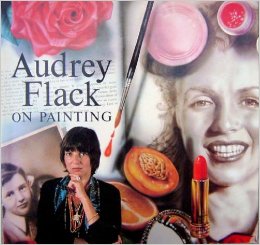
“Audrey Flack on Painting” (1986), cover.
Nor does it make sense to argue that working from one’s own images (instead of someone else’s) justifies the practice. Painting from photographs is painting from photographs; deriving photographs from paintings doesn’t become a different act if the paintings are one’s own. Photo-Realists Audrey Flack, Ralph Goings, and Chuck Close aren’t somehow more authentic or creative than Malcolm Morley because they work from their own photos and he doesn’t.
The same would hold true with a photographer in relation to paintings or other graphic works. Joel-Peter Witkin makes sketches of his elaborate directorial images before staging them, sometimes inventing the scenarios himself and sometimes premising them on paintings and photographs by others. I can’t imagine the plausible argument that would convince me the former are creatively superior to the latter.
Pot and Kettle
So we actually have two issues at play, which have only a tenuous philosophical connection linking them. The first constitutes an art-critical debate over the extent and specificity to which one picture-maker can mimic and/or recontextualize the work of another, in any medium, and still get taken seriously. Given the spectrum of contemporary critical and theoretical positions in re originality vs. cultural baggage, I don’t foresee any consensus emerging on this score.
 The second concerns what the constitutionally established copyright law allows as a visual artist’s “fair use” of the copyright-protected work of another visual artist. Here we have assorted historic cultural practices involving direct quotation, oblique reference, imitation, influence, homage, parody, and other responses that resist absolute quantification. All we can say is that without them the arts in general would be the poorer. Yet this has led to murky legislation that, predictably, has spawned a diverse gaggle of one-off case-law decisions, with the result that legal precedents both for and against any particular approach to praxis abound. Yikes.
The second concerns what the constitutionally established copyright law allows as a visual artist’s “fair use” of the copyright-protected work of another visual artist. Here we have assorted historic cultural practices involving direct quotation, oblique reference, imitation, influence, homage, parody, and other responses that resist absolute quantification. All we can say is that without them the arts in general would be the poorer. Yet this has led to murky legislation that, predictably, has spawned a diverse gaggle of one-off case-law decisions, with the result that legal precedents both for and against any particular approach to praxis abound. Yikes.
Just as copyright law shouldn’t get decided by critics of the visual arts, art criticism shouldn’t become the purview of sitting judges. I’ve seen no statistics on the matter, but I’ll wager that on average your judge in any copyright-violation lawsuit related to the visual arts has visited no more than four museums or art galleries per year, read no more than a dozen books on art, never made a studio visit to an artist’s workspace, and never sat down for a one-on-one conversation with a maker of images. Do we really want such uninformed figures deciding the degree to which a given work “transforms” its source materials?
Photographers Appropriating Paintings
What doesn’t get talked about during the periodic uproars over a painter’s appropriation of a photographer’s work are the numerous situations in which the shoe’s on the other foot. Consider the following examples:
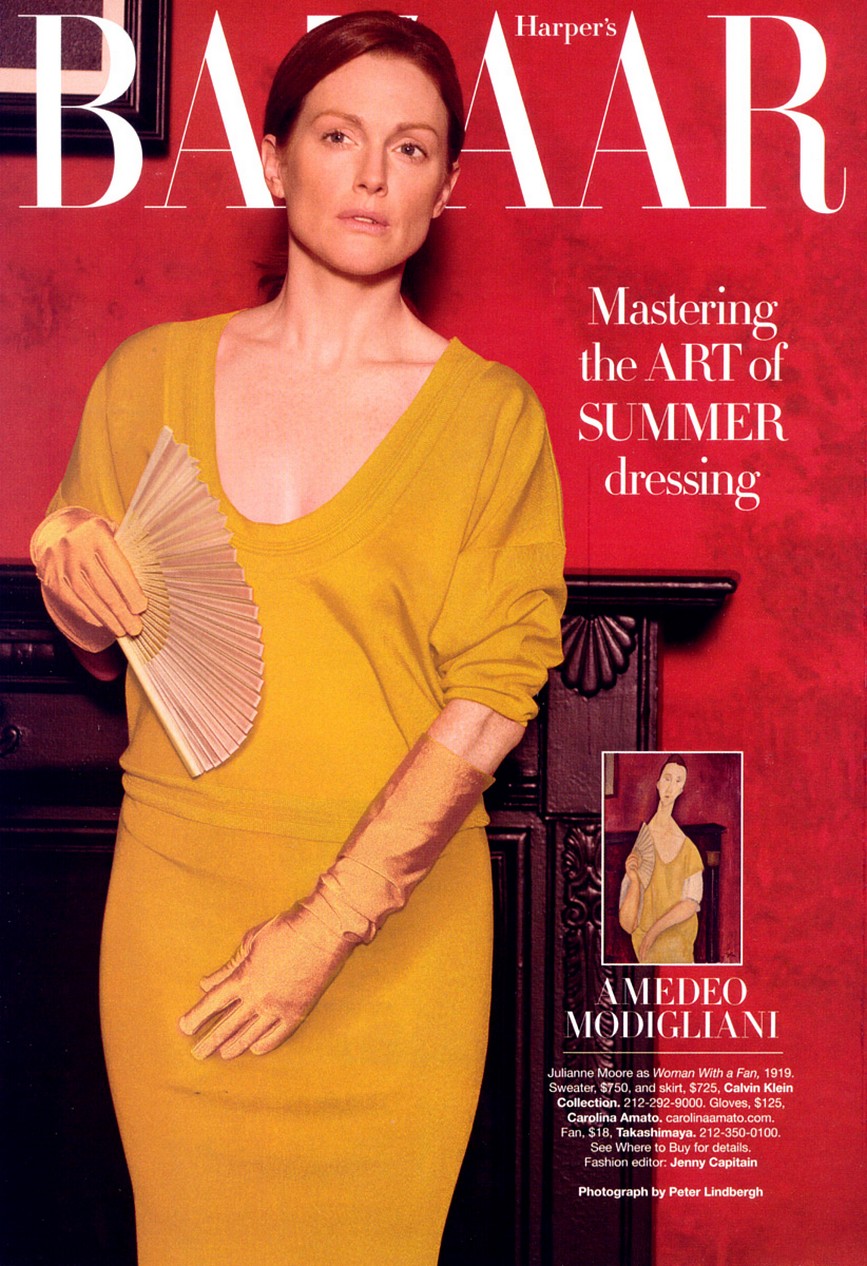
Harper’s Bazaar with Peter Lindbergh photograph (May 2008), cover.
• In 2008, photographer Peter Lindbergh worked with Hollywood actress Julianne Moore on a portfolio to accompany a profile of Moore for the May ’08 issue of Harper’s Bazaar. For this purpose Lindbergh and Moore recreated such famous works of graphic art as “The Cripple” (1997), by John Currin; “Woman With a Fan” (1919), by Amadeo Modigliani, seen here on the issue’s cover; “Seated Woman With Bent Knee” (1917), by Egon Schiele; “Man Crazy Nurse #3” (2003), by Richard Prince; “Madame X” (1884), by John Singer Sargent; and “Adele Bloch-Bauer I” (1907), by Gustav Klimt. Since at least some of the originals remain under copyright, and the magazine reproduced the originals alongside the restagings, I assume that Harper’s Bazaar licensed both reproduction rights and derivative-works rights wherever necessary. But I can’t say for sure.
• Japanese photographer Hisaji Hara meticulously restages the works of a famous 20th-century painter, in a series he has titled “A Photographic Portrayal of the Paintings of Balthus.” All the paintings of Balthus (Balthasar Klossowski de Rola, 1908-2001) remain under copyright protection; “Katia reading,” which Hara mimics in the image on this cover of the magazine Chinese Photography, dates from 1974. There’s no evidence that Hara licensed the right to produce these derivative works. Yet no one in the photo world chastises Hara for this; to the contrary, they celebrate his act of appropriation, publishing, exhibiting, and marketing the results.
• Hungarian photographer Flora Borsi makes self-portraits inspired by classic 20th-century paintings, then morphs her features digitally to resemble the artist’s original vision. Many of the originals remain under copyright protection; highly unlikely that Borsi licensed usage rights. Presumably overcome by her cuteness, Stephen Dowling at BBC Culture puffs the work of this 20-year-old in wide-eyed fashion, asking none of the relevant questions about rights, imitation, etc.
• Amy Arbus bases her most recent series, “After Images,” a set of color photographs, on classic modernist paintings (and some earlier ones). According to Dan Shaw’s July 19, 2013 report in the New York Times, “Inspired by her study of artists like Modigliani and Picasso, Ms. Arbus replicated their works, having sets painted and models made up, and then photographing them. Viewers are not sure whether they are looking at a painting or a photograph, which makes these hybrid images unnerving and hypnotic.” (Click here for the portfolio of this work at her website.) Shaw doesn’t ask her about copyright issues, but, given the famous fierceness with which the estate of Diane Arbus protects the late photographer’s work, I think it’s safe to assume that her daughter has obtained the necessary licenses for this project. (Again, I’m guessing.)
• The world’s oldest continuously running post-secondary photography school, the Rochester Institute of Technology, actively encourages its students to reenact historic and contemporary paintings, film and television scenes, and other visual icons, some of them certainly copyrighted. In 2011 they selected the 1830 painting “Liberty Leading the People” by Eugene Delacroix, but over the years they’ve also done the opening living-room scene from The Simpsons and a boxing match from Fight Club. Presumably no licensing took place. Thus this activity has entered the pedagogy of photography.
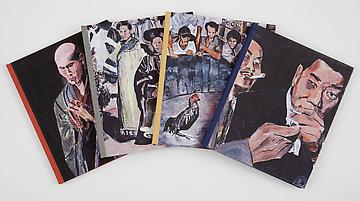
Bob Dylan, “The Asia Series,” catalogues, 2011
I don’t propose that any of the above photographers (and, in the RIT instance, the educators involved) have violated some spoken or unspoken rule of creative activity in working as they do. Pace Richard Polsky, “what the art experience is supposed to be about” has been up for grabs since Duchamp submitted a urinal to the Armory Show just over a century ago. Moreover, given the spectrum of what the courts have endorsed as legitimate “fair use,” I’d hesitate to offer even an informed layman’s opinion on how today’s courts would view their practices.
But I do insist on pointing out that none of these photographers has been subjected to the kind of critical bullying that bylined professionals inflicted on Bob Dylan for having the temerity to base his paintings on photographs. (As J. Ross Baughman’s recent post made clear, Dylan worked in a way exactly parallel to a project by Leon Golub, though he probably didn’t know it.) Nor have any been threatened with lawsuits for copyright violation, at least so far as I know.
So photographers’ commonplace practice of basing photographs on works of graphic art, often in detail and faithful to the originals, is celebrated, not condemned, by the very same community that objects, vociferously, when painters and other graphic artists imitate or derive iconography from photographic images. What inexplicable double standard operates here?
•
For an index of links to all posts related to this story, click here.
•
This post supported by a donation from Norbert Kleber.



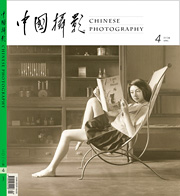
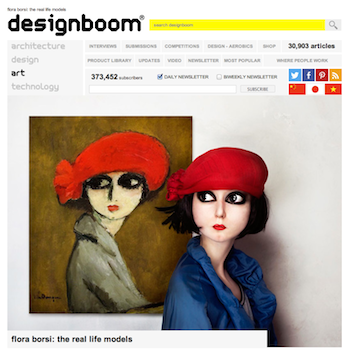




Disambiguation: Though I think it’s clear to any careful reader, a Facebook note from one photographer prompts me to affirm that this series of posts does not concern itself with “painterly” photographs (Rejlander, Robinson, the Photo-Secessionists), nor with picture-makers who paint with photo chemicals on light-sensitive paper.